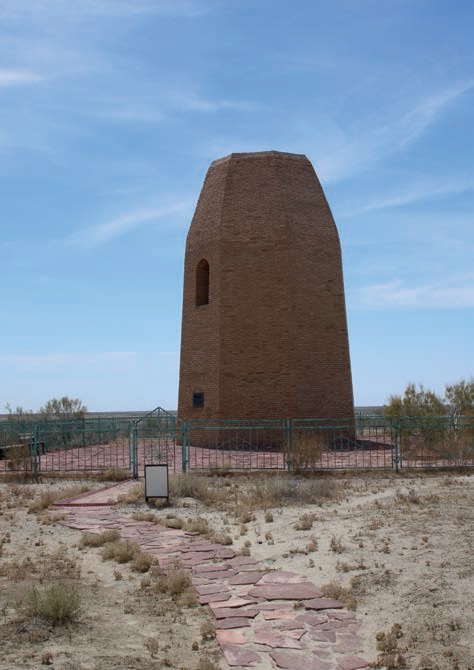On archaeological exploration work carried out in the vicinity of the medieval settlement Zhankent in 2019 and 2022
DOI:
https://doi.org/10.52967/akz2022.3.17.91.102Keywords:
archaeology, Zhankent, «marsh towns», Aral Sea region, medieval settlement, SyrdaryaAbstract
The article presents the results of new exploratory research conducted in the vicinity of the settlement of Zhankent. Since the Middle Ages, the monument has been under the constant attention of merchants, military travelers and statesmen. Medieval authors consider it as the residence of the Oghuz state. In the 18th–19th centuries, the main route of military topographic expeditions of tsarist Russia to Central Asia passed through Zhankent, and their reports contain information about the ruins of the city. Some military travelers even conducted small excavations. Among them, we can mention Lieutenant Colonel A. Maksheev, who left detailed information about toponyms and monuments near Zhankent. The surroundings of this monument were first archaeologically studied by the Khorezm archaeological and Ethnographic expedition led by S. Tolstov, and since 2005, the staff of the Kyzylorda University named after Korkyt Ata have conducted comprehensive research in cooperation with Russian and German scientists. In general, historical data indicates that in the 6th–7th centuries in the lower reaches of the Syrdarya there is a decline of the Zhetyasar culture. However, in the north-western part of the Zhetyasar tract, a group of Ordaza monuments is being formed (Sortobe 1–3 settlements) and on the eastern coast of the Aral Sea – the cities of Kesken-Kuyuk Kala, Kuyuk Kala and Zhankent, belonging to the culture of "swamp settlements". Exploration works in 2019 and 2022 in the Zhankent area show that there are still undiscovered monuments in this area. For example, as a result of archaeological research, the new cities of Karatobe and Asartobe and the trade routes connecting them were identified. Another purpose of the exploration was to search for the burial ground where the residents of Zhankent were buried.
References
Baipakov, K. M. 2013. Drevnyaya i srednevekovaya urbanizaciya Kazahstana (po materialam issledovaniy Yuzhno-Kazahstanskoy kompleksnoy arheologicheskoy ekspedicii). Kniga ІІ. Urbanizaciya Kazahstana v ІX – nachale XІІІ v. (Ancient and medieval urbanization of Kazakhstan (based on research materials of the South-Kazakhstan complex archaeological expedition). Book II. Urbanization of Kazakhstan in the 9th – the beginning of the 13th century). Almaty: MIA Publ. (in Russian).
Baipakov, K. M., Voyakin, D. A. 2009. In: Vestnik Mezhdunarodnogo instituta Tsentralnoaziatskih issledovaniy (Bulletin of IICAS), 10, 26-33 (in Russian).
Baipakov, K. M., Voyakin, D. A., Il'in R. V. 2012. In: Vestnik Vestnik Mezhdunarodnogo instituta Tsentralnoaziatskih issledovaniy (Bulletin of IICAS), 12, 22-44 (in Russian).
Baitenov, E. M. 1985. In: Pamyatniki istorii i kultury Kazahstana (Monuments of history and culture of Kazakhstan). Almaty: “Kazahstan” Publ., 45-46 (in Russian).
Baitenov, E. M. 1990. In: Arhitekturnoe nasledstvo (Architectural heritage), Issue 37. Moscow: “Strojizdat” Publ., 335-344 (in Russian).
Baitenov, E. M. 2007. In: Svod pamyatnikov istorii i kultury RK. Kyzylordinskaya oblast (The official list of Historical and Cultural monuments of the Republic of Kazakhstan. Kyzylorda Region). Almaty: “Aruna” Publ., 281-282 (in Russian).
Ibraev, B. A. 1980. In: Dekorativnoe iskusstvo SSSR (Decorative art of the USSR), 8, 40-44 (in Russian).
Kozha, M. B. 2014. In: Margulan readings – 2014. Almaty; Pavlodar: “Gylymi kazyna” Publ., 390-399 (in Russian).
Kurmankulov, Zh., Arzhantseva, I. A., Tazhekeyev, A. A. 2011. In: Korkyt Ata atyndagy Kyzylorda memlekettyk universitetynyn khabarshysy (Bulletin of Korkyt Ata Kyzylorda State University), 2, 27-32 (in Kazakh).
Levina, L. M. 1996. Etnokul'turnaya istoriya Vostochnogo Priaral'ya (v I tys. do n. e. – I tys. n. e.) (Ethno-cultural history of the Eastern Aral Sea region (in the 1st millennium BC - 1st millennium AD)). Moscow: “Vostochnaya literatura” Publ. (in Russian).
Levina, L. M. 1997. In: Etnograficheskoe obrozrenie (Ethnographic Review), 2, 3-14 (in Russian).
Maksheev, A. I. 1856. In: Morskoy sbornik izdavavshiysya mosrskim uchennym komitetom (Marine collection published by the Marine Scientific Committee), XXІІІ, 9. Saint Petersburg: “Tipografiya Imperatorskoj Akademii Nauk” Publ., 448-527 (in Russian).
Tazhekeyev, A. A. 2011. In: Al-Farabi atyndagy Kazakh Ulttyk universitetının khabarshysy. Tarih seriyasy (Bulletin of al-Farabi Kazakh National University. History series), 2 (61), 74-79 (in Kazakh).
Tazhekeyev, A. A. 2017. In: Kazakstannyn kielі oryndarynyn geografiyasy. Tabigat, arheologiya, etnografiya zhane dini saulet onerі nysandarynyn tіzіlіmі (Geography of sacred places in Kazakhstan. Register of objects of nature, archeology, ethnography and religious architecture). Almaty: MIA Publ., 498-500 (in Kazakh).
Tazhekeyev, A. A., Sultanzhanov, Zh. K. 2018. In: Al-Farabi atyndagy Kazakh Ulttyk universitetının khabarshysy. Tarih seriyasy (Bulletin of al-Farabi Kazakh National University. History series), 1 (88), 239-246 (in Kazakh).
Tolstov, S. P. 1947. In: Sovetskaya etnografiya (Soviet ethnography), 3, 55-102 (in Russian).
Tolstov, S. P. 1948. Po sledam drevnekhorezmiyskoy tsivilizatsii (In the footsteps of ancient Khorezmian civilization). Moscow; Leningrad: “USSR Academy of Sciences” Publ. (in Russian).
Tolstov, S. P. 1962. Po drevnim deltam Oksa i Yaksarta (Along the ancient deltas of the Oxus and Jaxartes). Moscow: “Vostochnaya literatura” Publ. (in Russian).

Downloads
Published
How to Cite
Issue
Section
License
Copyright (c) 2022 Азилхан Тажекеев, Жетесби Султанжанов

This work is licensed under a Creative Commons Attribution-NonCommercial 4.0 International License.






